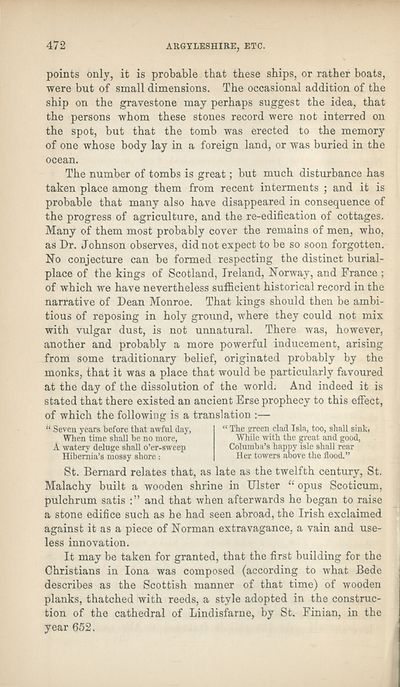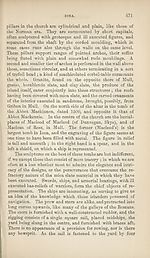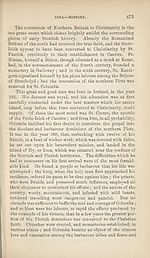Download files
Complete book:
Individual page:
Thumbnail gallery: Grid view | List view

472
ARGYLLSHIRE, ETC.
points only, it is probable that these ships, or rather boats,
were but of small dimensions. The occasional addition of the
ship on the gravestone may perhaps suggest the idea, that
the persons whom these stones record were not interred on
the spot, but that the tomb was erected to the memory
of one whose body lay in a foreign land, or was buried in the
ocean.
The number of tombs is great; but much disturbance has
taken place among them from recent interments ; and it is
probable that many also have disappeared in consequence of
the progress of agriculture, and the re-edification of cottages.
Many of them most probably cover the remains of men, who,
as Dr. Johnson observes, did not expect to be so soon forgotten.
No conjecture can be formed respecting the distinct burial-
place of the kings of Scotland, Ireland, Norway, and France ;
of which we have nevertheless sufBcient historical record in the
narrative of Dean Monroe. That kings should then be ambi¬
tious of reposing in holy ground, where they could not mix
with vulgar dust, is not unnatural. There was, however,
another and probably a more powerful inducement, arising
from some traditionary belief, originated probably by the
monks, that it was a place that would be particularly favoured
at the day of the dissolution of the world. And indeed it is
stated that there existed an ancient Erse prophecy to this effect,
of which the following is a translation :—
“ Seven years before that awful day, I “ The sreen clad Isla, too, shall sink,
When time shall be no more, "While with the great and good,
A watery deluge shall o’er-sweep Columba’s happy isle shall rear
Hibernia’s mossy shore : | Her towers above the flood.”
St. Bernard relates that, as late as the twelfth century, St.
Malachy built a wooden shrine in Ulster “ opus Scoticum,
pulchrum satis and that when afterwards he began to raise
a stone edifice such as he had seen abroad, the Irish exclaimed
against it as a piece of Norman extravagance, a vain and use¬
less innovation.
It may be taken for granted, that the first building for the
Christians in Iona was composed (according to what Bede
describes as the Scottish manner of that time) of wooden
planks, thatched with reeds, a style adopted in the construc¬
tion of the cathedral of Lindisfarne, by St. Finian, in the
year 652.
ARGYLLSHIRE, ETC.
points only, it is probable that these ships, or rather boats,
were but of small dimensions. The occasional addition of the
ship on the gravestone may perhaps suggest the idea, that
the persons whom these stones record were not interred on
the spot, but that the tomb was erected to the memory
of one whose body lay in a foreign land, or was buried in the
ocean.
The number of tombs is great; but much disturbance has
taken place among them from recent interments ; and it is
probable that many also have disappeared in consequence of
the progress of agriculture, and the re-edification of cottages.
Many of them most probably cover the remains of men, who,
as Dr. Johnson observes, did not expect to be so soon forgotten.
No conjecture can be formed respecting the distinct burial-
place of the kings of Scotland, Ireland, Norway, and France ;
of which we have nevertheless sufBcient historical record in the
narrative of Dean Monroe. That kings should then be ambi¬
tious of reposing in holy ground, where they could not mix
with vulgar dust, is not unnatural. There was, however,
another and probably a more powerful inducement, arising
from some traditionary belief, originated probably by the
monks, that it was a place that would be particularly favoured
at the day of the dissolution of the world. And indeed it is
stated that there existed an ancient Erse prophecy to this effect,
of which the following is a translation :—
“ Seven years before that awful day, I “ The sreen clad Isla, too, shall sink,
When time shall be no more, "While with the great and good,
A watery deluge shall o’er-sweep Columba’s happy isle shall rear
Hibernia’s mossy shore : | Her towers above the flood.”
St. Bernard relates that, as late as the twelfth century, St.
Malachy built a wooden shrine in Ulster “ opus Scoticum,
pulchrum satis and that when afterwards he began to raise
a stone edifice such as he had seen abroad, the Irish exclaimed
against it as a piece of Norman extravagance, a vain and use¬
less innovation.
It may be taken for granted, that the first building for the
Christians in Iona was composed (according to what Bede
describes as the Scottish manner of that time) of wooden
planks, thatched with reeds, a style adopted in the construc¬
tion of the cathedral of Lindisfarne, by St. Finian, in the
year 652.
Set display mode to:
![]() Universal Viewer |
Universal Viewer | ![]() Mirador |
Large image | Transcription
Mirador |
Large image | Transcription
| Antiquarian books of Scotland > Scotland/Scots > Black's picturesque tourist of Scotland > (592) |
|---|
| Permanent URL | https://digital.nls.uk/130035294 |
|---|
| Description | Thousands of printed books from the Antiquarian Books of Scotland collection which dates from 1641 to the 1980s. The collection consists of 14,800 books which were published in Scotland or have a Scottish connection, e.g. through the author, printer or owner. Subjects covered include sport, education, diseases, adventure, occupations, Jacobites, politics and religion. Among the 29 languages represented are English, Gaelic, Italian, French, Russian and Swedish. |
|---|

